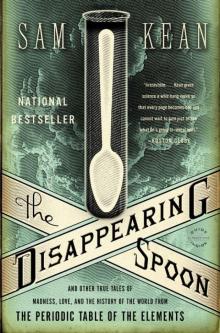Read Sam Kean Storyline:
The Periodic Table is one of man's crowning scientific achievements. But it's also a treasure trove of stories of passion, adventure, betrayal, and obsession. The infectious tales and astounding details in THE DISAPPEARING SPOON follow carbon, neon, silicon, and gold as they play out their parts in human history, finance, mythology, war, the arts, poison, and the lives of the (frequently) mad scientists who discovered them.We learn that Marie Curie used to provoke jealousy in colleagues' wives when she'd invite them into closets to see her glow-in-the-dark experiments. And that Lewis and Clark swallowed mercury capsules across the country and their campsites are still detectable by the poison in the ground. Why did Gandhi hate iodine? Why did the Japanese kill Godzilla with missiles made of cadmium? And why did tellurium lead to the most bizarre gold rush in history?From the Big Bang to the end of time, it's all in THE DISAPPEARING SPOON. From Publishers WeeklyScience magazine reporter Kean views the periodic table as one of the great achievements of humankind, "an anthropological marvel," full of stories about our connection with the physical world. Funny, even chilling tales are associated with each element, and Kean relates many. The title refers to gallium (Ga, 31), which melts at 84ËšF, prompting a practical joke among "chemical cognoscenti": shape gallium into spoons, "serve them with tea, and watch as your guests recoil when their Earl Grey ̃eatsTM their utensils." Along with Dmitri Mendeleyev, the father of the periodic table, Kean is in his element as he presents a parade of entertaining anecdotes about scientists (mad and otherwise) while covering such topics as thallium (Tl, 81) poisoning, the invention of the silicon (Si, 14) transistor, and how the ruthenium (Ru, 44) fountain pen point made million for the Parker company. With a constant flow of fun facts bubbling to the surface, Kean writes with wit, flair, and authority in a debut that will delight even general readers. 10 b&w illus. Copyright © Reed Business Information, a division of Reed Elsevier Inc. All rights reserved. From BooklistLike big-game hunters, scientists who stalked an undiscovered element courted peril: Marie Curie and Enrico Fermi both died from exposure to dangerous elements in the course of their experiments. But besides them and Dmitri Mendeleev, the deviser of the periodic table, which looms over science classrooms everywhere, few discoverers of the elements occupy the consciousness of even avid science readers. Kean rectifies that in this amble from element 1, hydrogen, to element 112, copernicium. Attaching stories to a human-interest angle, Kean ensures that with his elaboration of the fixation a chemist, physicist, industrialist, or artist had for a particular element comes clarity about why the element behaves as it does. The soft sell about proton numbers and electron shells thus closes the deal for Kean’s anecdotes about elements of war, elements of health, and elements of wealth, plus the title’s practical joke of a spoon (made from gallium). Whether explaining why Silicon Valley is not Germanium Valley or reveling in naming-rights battles over a new element, Kean holds interest throughout his entertaining debut. --Gilbert TaylorPages of Sam Kean :
